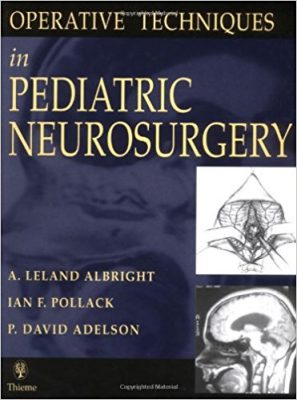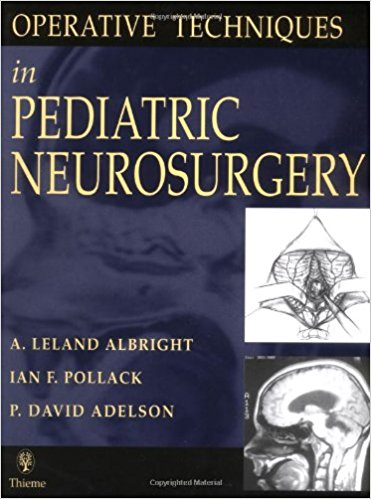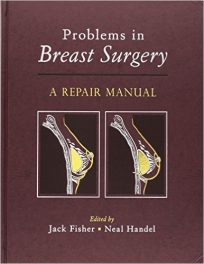 Editors: A. Leland Albright, MD; Ian F. Pollack, MD; and P. David Adelson, MD
Editors: A. Leland Albright, MD; Ian F. Pollack, MD; and P. David Adelson, MD
Publisher: Thieme – 288 pages
Book Review by Nano Khilnani
The hallmark of this book published in 2001 is that the contributors are experienced neurosurgeons who have developed good-to-great reputations based on successful outcomes of the various operations they have performed. Their work has been effective in eliminating the problems they discovered during the diagnosis of their patients.
Thirty-one specialists in neurological surgery (particularly for children), general surgery, and plastic, aesthetic and reconstructive surgery, from around the United States and three other countries – Canada, Israel, Japan – wrote the 25 chapters of this book on pediatric neurosurgery. The chapters are organized around five Sections.
Too numerous to list the chapter titles here, the chapters cover a large range of subjects. What we are doing below is to name the subjects covered in the chapters within each Section, so that you will get an idea of what is covered (or not) in this book:
- Section I: Congenital and Developmental Disorders: cerebrospinal fluid shunts, Chiari malformations, craniofacial syndromes, craniosynostosis, dermal sinuses, Encephaloceles, Meningoceles, Myelomeningoceles, neuroendoscopy, Spina Bifida Occulta, and surgery at the craniocervical junction.
- Section II: Neoplasms: brain tumors during the first two years of life, intraspinal intramedullary neoplasms intraspinal extramedullary neoplasms, midline intra-axial neoplasms, posterior fossa neoplasms, skull-base neoplasms, and supratentoria hemispheric tumors.
- Section III. Trauma: cranioplasty techniques, repair of skull fractures, and supraclavicular approach to birth-related brachial plexus injury.
- Section IV: Vascular Disease: Moyamoya disease, and vascular malformations.
- Section V: Functional Disorders: corpus collosotomy, hemispherectomy, pump insertions, and temporal-lobe epilepsy.
A systematic outline and presentation of materials is characteristic of each chapter, which makes it easy for the student, particularly one who is preparing for a board exam, to search for, locate the topic, and note the answers to their questions and to potential entries in exams.
Let’s take a look at chapter 10, Brain Tumors During the First Two Years of Life, in Section II.
These are the materials outlined:
- Chapter title
- Bylines
- Surgical Indications and Preoperative Evaluation
- Preoperative Management
- Intra-operative Techniques
- Anesthesia and Positioning
- Surgery
- Functional Brain Mapping
- Elctrocorticography
- Surgical Navigation
- Tumor Removal
- Closure
- Postoperative Management
- Editor’s Commentary
- Pearls: In these authors’ experience
- Suggested Readings
As in other areas of medicine, the practice of neurosurgery and its subspecialty pediatric neurosurgery has become more effective with better outcomes due to great technological advances in diagnosis and treatment of patients with a large number of disorders as shown within the list of 5 Sections.
In recent years, developments in neuro-imaging, navigational techniques, new surgical tools, and a constant stream of pharmaceuticals have greatly helped neurosurgeons in pinpointing disorders and treating them more effectively and in less time than ever before.
When writing their Preface to this book before it was published in 2001, the editors wrote they were hopeful that “within the next 15 years,” we may witness the following:
- Advances in inutero surgery may improve the prognosis with spina bifida
- Deep brain stimulation may improve the outlook for those with movement disorders
- Radiosurgery may treat those with mesial temporal lobe seizures
- Gene therapy may help both brain tumors and congenital metabolic disorders
Some of these and other improvements have already been realized, while others are being worked on. In sum, it is always good when progress has been made or is in the process of realization.
This book, by gathering and disseminating knowledge of the current techniques in neurosurgery, is providing a great service to pediatric neurosurgeons, and we commend its editors and authors for a job very well done.
Editors:
A Leland Albright, MD is Professor of Neurological Surgery at the University of Pittsburgh School of Medicine. He is also Chief of Pediatric Neurosurgery at Children’s Hospital of Pittsburgh in Pittsburgh, Pennsylvania.
Ian F. Potlack, MD, FACS is Professor of Neurological Surgery at the University of Pittsburgh School of Medicine and at Children’s Hospital of Pittsburgh in Pittsburgh. He is also Co-Director of the University of Pittsburgh Camcer Institute Brain Tumor Center in Pittsburgh, Pennsylvania
David Adelson, MD, FACS is Associate Professor of Neurological Surgery at the University of Pittsburgh School of Medicine and at Children’s Hospital of Pittsburgh in Pittsburgh, Pennsylvania.






